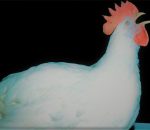Mareks disease in chickens is an infectious lymphomatous and neuropathic disease of domestic fowl caused by the herpes virus. Mareks disease was first reported by a Hungarian Veterinary Pathologist in 1907.
This disease is caused by the cell-associated herpes virus. This virus is characterized by double-stranded DNA and it is not covered by the outer envelope. The virus remains highly cell-associated (intra-nuclear), while only a small amount of the virus is free.
Commonly these viruses are grouped into three serotypes depending upon their antigenic differences.
Serotype 1: these viruses are pathogenic strains of MD
Serotype 2: Naturally apathogenic strains of MD
Serotype 3: Naturally avirulent herpes virus of turkey birds.
Clinical Signs of Mareks disease
In Marek’s disease (MD), birds manifest a broad variety of signs.
- Weight loss and anorexia
- Diarrhea and dehydration
- Transient paralysis resulting in high mortality
- Anemia with sudden death
- Sometimes lymphoid organs are also affected
- In acute (visceral) form, Visceral lymphomas are most prevalent and bird losses are often up to 30%.
- In classical form ( chronic form ), locomotor disturbances and incoordination are the early signs that are observed.
- Partial or complete paralysis of legs and wings occurs due to peripheral nerve involvement.
- In Cutaneous form (skin leucosis), the skin around feather follicles is raised due to lymphoid infiltration, and skin is roughened.
- Ocular leucosis is usually seen in early maturity and it includes
- The grey iris,
- Irregular pupil size,
- Vision impairment.
- Affected birds are immunosuppressed and are prone to other diseases. Infield condition, coccidiosis follows Marek’s disease.
- Twisted neck (torticollis)

Postmortem lesions
- Grey-white focal or diffused neoplastic tissue and acute lymphomas are observed in several visceral organs.
- Liver enlargement
- Grayish translucent tumorous follicles are commonly seen in kidneys, lungs, heart, ovary, gonads, and spleen
- The thick and firm proventriculus.
- Tiny whitish streaks to nodular tumors are found on skeletal muscles
- Bursa of Fabricius is decreased in size, although diffuse tumors may develop.
- Nerve enlargement is the classical form of the disease and this the characteristic lesion of marek’s disease for chickens.
- Nerve involvement is best observed in the sciatic nerve, brachial and sciatic plexuses.
- Affected nerves appear greyish or yellowish and sometimes edematous
- Lymphomas are sometimes present in the classical form of Marek’s disease MD.
Differential Diagnosis of marek’s disease
- Lymphoid Leucosis
- MD lymphomas show heterogenous population of lymphoid cells while in lymphoid leucosis lymphomatous infiltrations are composed of uniform lymphoblasts.
- Peripherl nerve lesions are not a characteristic feature of lymphoid leucosis.
- Lymphoid tumors under the age of 18 weeks will always be a feature of marek’s disease in chickens.
- Reticuloendotheliosis (RE)
- Nerve lesions and lymphomatous proliferation may also be induced by certain strains of the RE virus. However, the RE virus is not common in chicken flocks. Differentiate using virological and serological tests.
- Botulism
- Tuberculosis & histomoniasis
- Myeloblastosis and carcinoma of the ovary and other neoplasma.
- Deficiency of thiamine, riboflavin, calcium, phosphorus, and vitamin D.
- Skin lesions (pigmentation, and enlarged follicles).


